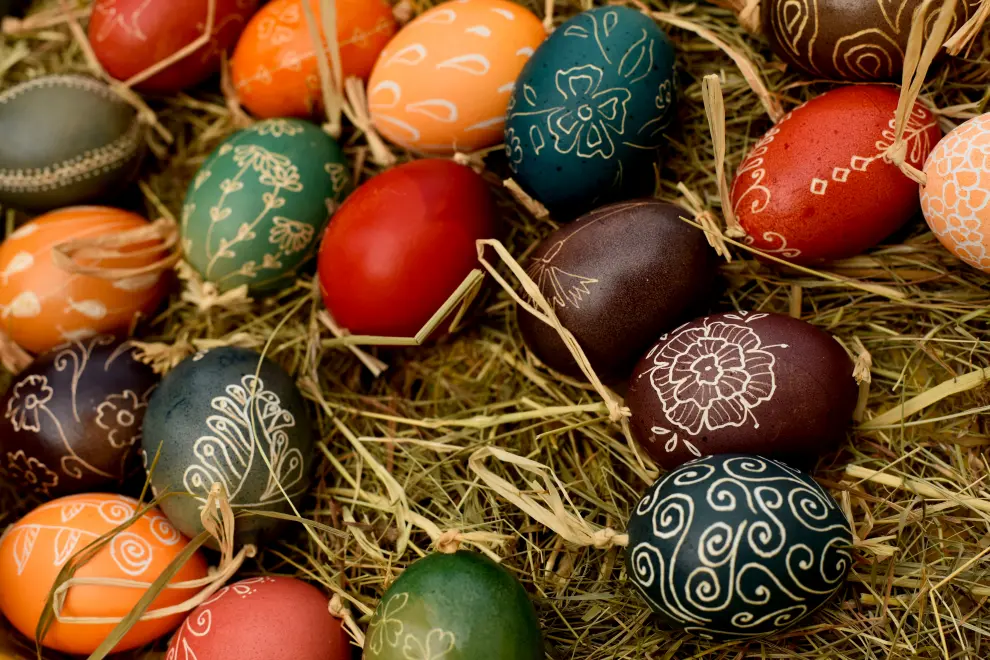Easter dishes imbued with symbolism
Slovenia has a rich heritage of Easter customs, which vary from one part of the country to another, just like the dishes served on the occasion. Imbued with symbolism, the dishes are the centrepiece of family gatherings.
Easter festivities will culminate with processions and holy masses glorifying the resurrection of Jesus Christ in the predominantly Catholic Slovenia on Sunday, followed by family gatherings.
Religious and many non-religious families will get together for the traditional Easter breakfast, a feast consisting of the food that will have been taken to blessings in wicker baskets on Easter Eve.
A typical basket includes pirhi, the elaborately decorated hard-boiled eggs, as well as ham, horse radish, the potica cake, and selected local specialities.
The festively laid out table with Easter dishes is an opportunity for people to get together and talk, while it is also a showcase of the rich cultural heritage, ethnologist Janez Bogataj has told the STA.
It is not just Easter breakfast, but also the preparations for it which are social occasions in their own right, gathering family members and friends together in an effort to make the dishes perfect.
https://youtu.be/tKPW_AL17m0
Each of the Easter dishes that are taken to blessings at churches and chapels across the country has its own iconographic meaning associated with the crucifixion.
"The meat is a symbol of Christ as the sacrificial, offering lamb. The horseradish represents the nails with which he was nailed to the cross, and the pirhi symbolise his wounds. At the same time, they are a symbol of the resurrection itself," says Metod Benedik, a theologian and church historian.
Potica may not always be potica
Potica, a crown-shaped cake made of rolled out pastry filled with nuts or some other fillings, seems essential to any Easter feast in Slovenia.
However, in some parts of the country the pastry dish in the Easter basket is not potica. In Haloze, in the north-east, they make bidrih, a cake made of leavened dough with milk and raisins.
Further east, in Prekmurje, the basket contains vrtanek, a braided wreath-shaped white-flour flat cake, and the Primorska region and Istria, at the other end of the country, have pinca or a sweet white bread.
Housewives in some places in Dolenjska in the south-east and Goriška in the west will bake small braided buns with a decorated hard-boiled egg on top for each child.
Ham and cured meats
The basket will usually contain lightly smoked ham, but in the upper Savinja Valley in the north it is replaced with Zgornjesavinjski želodec, a cured meat delicacy where the stuffing of pork meat and bacon used to be stuffed into the casing of 'pig stomach'.
The meat dish in Jezersko in the north, is bula, a baked mixture of minced veal or lamb, white bread, eggs, minced lard and bacon and cured meat. The only thing housewives there will talk about before Easter is how well their bula turned out, the STA learnt at a local farmstay.
In Dobrepolje and Velike Lašče in Dolenjska, buckwheat štruklji, a sort of dumplings made of dough and pieces of cured pork, are boiled in the water in which the Easter ham was cooked. Instead of meat, some will use sausages or even dried figs, says Marija Nučič, the head of the local women's association.
Wine makes an important part of the Easter meal, in particular in the wine-making regions. Bogataj says a sprig of wormwood is put in the wine a few days earlier in some parts to represent the sponge dipped in vinegar that was offered to Jesus to drink from during the crucifixion. The wine with wormwood aroma also functions as a digestive.
Easter games and customs
Many families and villages still hold traditional egg competitions, where pirhi or the decorated hard-boiled eggs are rolled, bowled with or involve competitors trying to target them with a coin so it gets stuck in the egg or cuts it in half.

Pirhi. Photo: STA
In many a village, Easter processions are accompanied by bell-ringing and loud banging produced by small cannons or mortars using gunpowder or carbide in a custom imitating the cracking of rocks during Christ's resurrection.
The smaller Protestant community, centred in the north-east of the country, will have children hunting for Easter eggs and bunnies.


